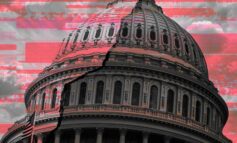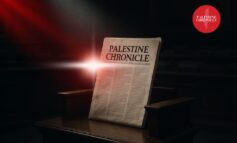
|
| Relatives of journalist Halid Ahmed who died during the attack of Israel, mourn near his funeral on July 20, 2014. |
Appropriately, thousands of comics have been published in response to the Charlie Hebdo attacks earlier this month. One of the most striking ones I’ve seen so far depicts the gunmen as they fire at the magazine’s office; their bullets burst through the building, out the back, and riddle holes in the minaret of a mosque in the distance.
Indeed, the Paris attacks — while not representative of Islam or any Muslim I’ve ever met — are bound to have a negative impact on Muslims, especially in the West. In fact, I worry that if we’re not keenly aware of our reaction to the attacks, they could contribute to a shift from multiculturalism toward xenophobia, even in diverse cities like Detroit.
Just a few weeks before the Paris attacks, I returned to the Detroit area after spending over a year working my first journalism job at a Palestinian news agency in the West Bank.
During my time abroad, as I got a feel for some of the cultures of the Middle East, American anxiety about the region and about Islamic extremism rose to perhaps its highest level since the aftermath of Sept. 11, 2001. As I kept an eye on U.S. media trends, I watched as the disintegration of Syria and Iraq led to the rise of the “Islamic State” group and as cable news channels began to feature nightly segments on “jihadism.”
Later, many Americans would wholeheartedly support U.S. airstrikes on IS in Syria, while just a year before they had shunned President Obama’s plan to strike Bashar al-Assad’s forces in the same country. Something had changed. Americans had begun to feel threatened by the images they saw on the news.
Working in journalism in Palestine, I discovered the impact the media can have on people’s views and actions. It is a powerful thing to learn of the death of someone who looks like you at the hands of extremists.
In June, when three young Israeli settlers were kidnapped by Palestinian assailants, the world followed the military search campaign on the nightly news. An hour didn’t pass on Israeli media without a mention of the three teenagers. When it became known weeks later that the teens had been killed, all hell broke loose in Israel.
Young Israelis marched through the streets of Jerusalem, decrying the murder, many of them shouting “Death to Arabs.” After the funerals, Palestinians watched in horror as it came out that a group of Israeli ultra-nationalists had, the following day, kidnapped and burned alive a 16-year-old Palestinian from East Jerusalem. Hits on our website soared — the story dominated Palestinian media and set off mass protests across the West Bank.
Selective outrage?
While U.S. media followed the above stories, Americans were even more thrown when IS released videos of the murders of journalists James Foley and Steven Sotloff. Though Syrians had been dying by the thousands every month for two years, that was old news for U.S. viewers at this point — hardly primetime material.
Now, two young, White Americans had been killed in cold blood. Footage of the two men in orange jumpsuits, kneeling in the Syrian desert beneath the blade of a cloaked, British-accented IS militant, played on the news for weeks in an endless loop, the images etching themselves into the minds of the viewers. They couldn’t look away. When President Obama swiftly announced U.S. airstrikes in Syria, Americans barely batted an eye.
The news of the slain journalists certainly left viewers shaken. And yet, stories of similar and perhaps even greater magnitude passed unnoticed or under-appreciated. For example, the average media consumer probably doesn’t remember when the Israeli army killed a 14-year-old Palestinian with American citizenship in the West Bank in October.
But he or she likely does remember when a Palestinian drove a car into an East Jerusalem tram station, killing an Israeli infant with American citizenship the same month. Another example: Everybody is outraged (and rightly so) that 17 people in Paris, among them 10 journalists, were killed over the course of three days in attacks by extremists earlier this month.
But how many realize or are equally outraged by the fact that 17 journalists were killed by Israeli attacks on the Gaza Strip during last summer’s military offensive? Why is the Charlie Hebdo attack an assault on freedom of expression while the Israeli military’s killing of journalists is an expression of Israel’s right to defend itself?
One party to be blamed for this lack of balance is the media itself. Media has a responsibility to give due weight to stories involving human tragedy, no matter the nationalities, races, or religions involved.
But we also must point the finger at ourselves as consumers, gobbling down certain stories and ignoring others of equal or greater magnitude. Our response is often to accentuate the plight of those who look like us while downplaying that of others.
When a perceived threat toward “us” comes from those who we consider “others”, our response is far too often to stick with our respective groups, keeping “them” at arm’s length.
And if we choose to react this way in the wake of the current turbulence in the Middle East and the recent attacks in Paris, then we can only expect that Muslim- and Arab-Americans will become further isolated and discriminated against in the West.
Beyond Islamophobia
What if the American public responded this way not just to anxiety about “radical Islam”, but other domestic anxieties as well? Could last year’s events in Ferguson and New York also engender this type of reaction? Given the ease with which some Americans make assumptions about everyday Muslims and Islam in general, I worry that racial tensions stoked by #BlackLivesMatter and #ICantBreathe could lead to greater distrust not only between communities of color and law enforcement, but also between Black folks and White folks in general.
Even as many were horrified by the military response police employed against protesters following the decision not to indict officers in the deaths of Michael Brown and Eric Garner, the media inevitably focused on images of burning objects, looted stores and “rioting.”
In the case of Ferguson, while media consumers were up in the air about the rights and wrongs of Brown’s death, there was consensus on condemnation of looting and the few violent protesters involved in the aftermath. (One online commentator responded to this phenomenon with: “If only Michael Brown had been a 7-Eleven, you might have been outraged over his demise, too.”)
Could the endless clips of fires in Ferguson and angry protesters in New York contribute to further racial estrangement at a time when solidarity otherwise has the potential to bring people together?
In a place like Detroit, could widespread xenophobic reactions to the nightly-broadcast images of “rioting”, looting and urban crime lead to a greater divide between White and Black people?
It certainly has in the past — fearful and sometimes prejudiced reactions to the 1967 race riots led to the depopulation of swathes of Detroit and to the rise of rather un-diverse suburbs like Livonia where I grew up. White flight’s impact on the economic crisis in Detroit, in addition to ongoing racial and class-based tensions between urbanites and suburbanites in the Metro area, is obviously something we’re all still feeling today. Nearly 50 years later, as Detroit recovers from its wounds, it is of utter importance not to let “fear of the other” lead to something that tragic again.
I saw another comic the other day, another appropriately satirical one crafted in response to the Charlie Hebdo attacks. The last lines of the comic make a mockery of a far-too-common reaction to fear and outrage, the one I speak of in this article.
“Perhaps when we tire of holding up our middle finger we can try to think about why the world is the way it is… and what it is about Muslims in this time and place that makes them unable to laugh off a mere image,” it reads. “And if we answer ‘Because something is deeply wrong with them’ — certainly something was deeply wrong with the killers — then let us drive them from their homes and into the sea… for that is going to be far easier than sorting out how we fit in each other’s world.”
-Graham Liddell is a journalist who recently returned from Bethlehem, Palestine where he worked for Ma’an News Agency.





Leave a Reply